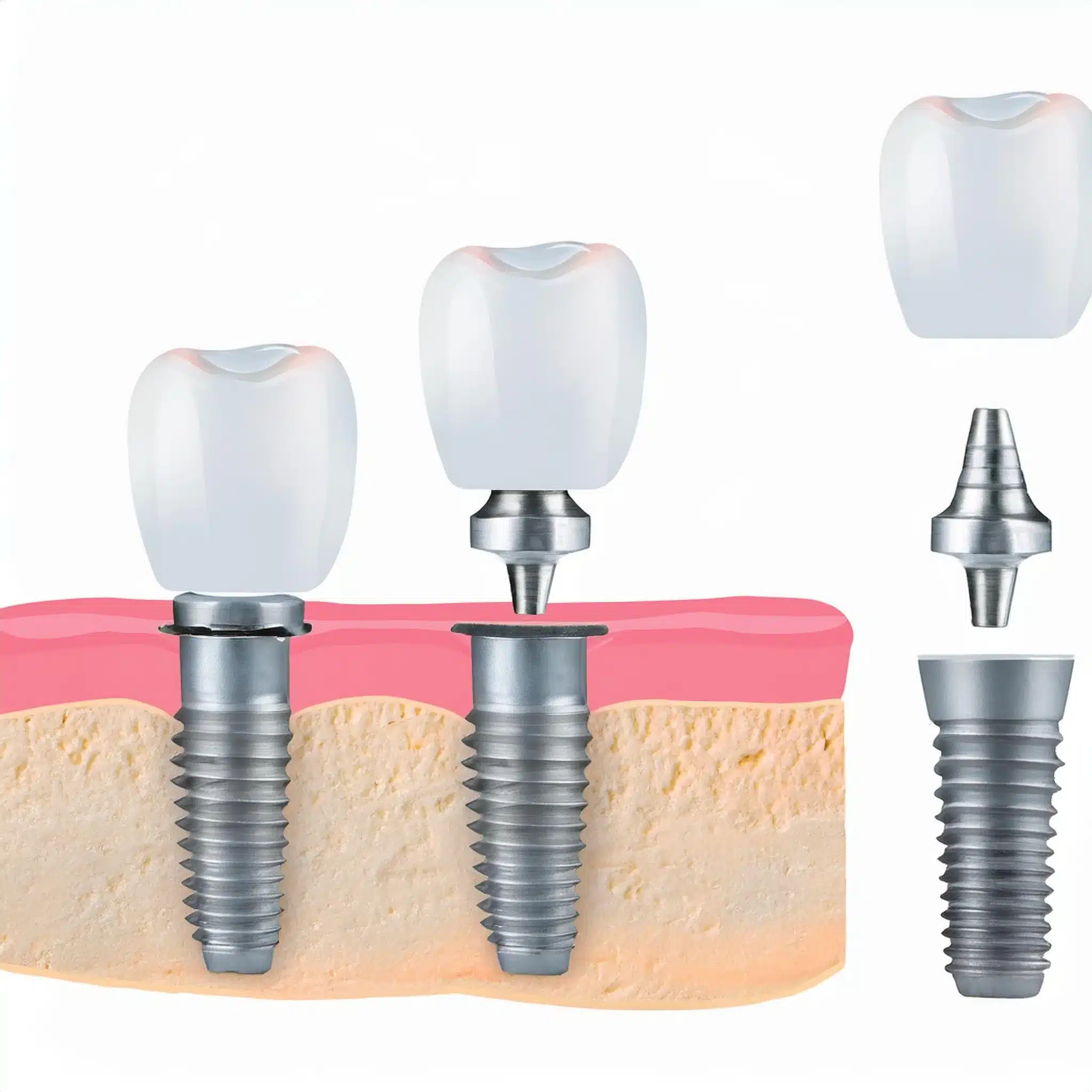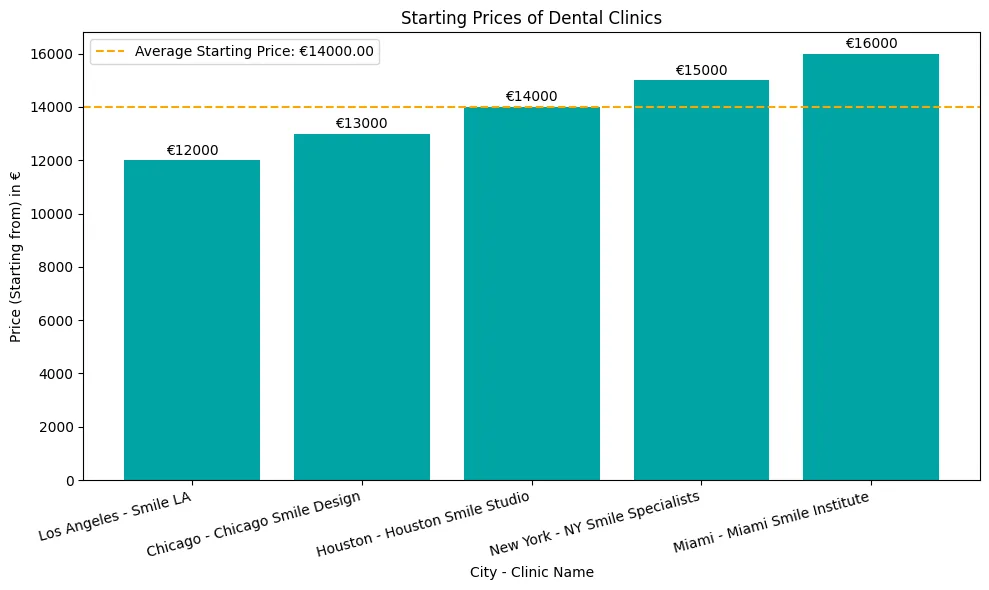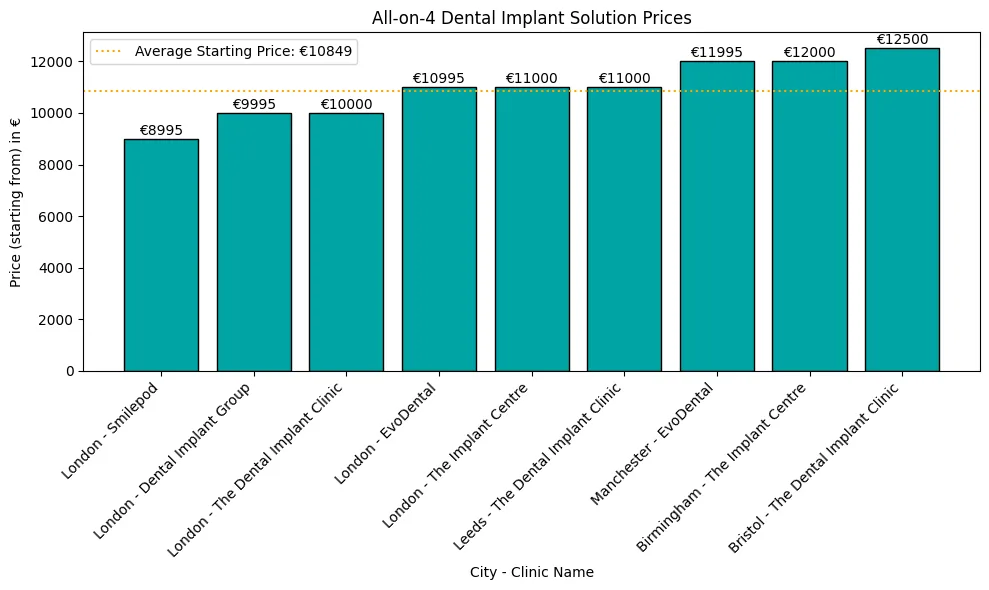Implanti dentar Komponentët dhe instalimi janë një konsideratë thelbësore për ata që kërkojnë një zgjidhje të përhershme për dhëmbët që mungojnë.
Nëse jeni një nga milionat që po luftojnë me humbjen e dhëmbëve, ka të ngjarë të pyesni veten se çfarë përbën një implant dentar dhe si është instaluar për të siguruar një buzëqeshje me pamje natyrale dhe funksionale.
Cilat janë përbërësit e implanteve dentare?
Komponentët e implanteve dentare janë: implanti, mbështetësja dhe kurora protetike. Implanti futet kirurgjikalisht në kockën e nofullës, mbështetësja lidh implantin me kurorën dhe kurora zëvendëson pjesën e dukshme të dhëmbit. Me një shkallë suksesi mbi 95%, implantet dentare ofrojnë një zgjidhje të qëndrueshme, që zgjat deri në 15 vjet.
| Komponenti | Përshkrimi | Materiali |
|---|---|---|
| Implanti | Futet kirurgjik në kockën e nofullës për të zëvendësuar rrënjën e dhëmbit që mungon | Titanium |
| Abatment | Lidh implantin me kurorën e protezës | Titan ose Qeramikë |
| Kurorë protetike | Zëvendëson dhëmbin ose dhëmbët që mungojnë | Qeramike ose Porcelani |
Komponentët e Implantit Dentar dhe Funksionet e tyre
Ngjitës (Post implanti)
Ngjitësja, e njohur edhe si shtylla e implantit dentar, është pjesa e implantit dentar që vendoset në mënyrë kirurgjikale në kockën e nofullës.
Zakonisht është bërë prej titani dhe është projektuar për t'u integruar me indin e eshtrave përreth.
Studimet kanë treguar se implantet me sipërfaqe të lëmuara (të kthyera) kanë më pak gjasa të humbasin kockën për shkak të infeksionit kronik (peri-implantitis) sesa implantet me sipërfaqe më të vrazhda (1).
Abatment
Abatmenti i implantit është lidhësi që lidh shtyllën e implantit me kurorën e protezës.
Zakonisht është prej titani ose qeramike dhe është projektuar për të siguruar një lidhje të sigurt dhe të qëndrueshme midis implantit dhe kurorës.
Ekzistojnë lloje të ndryshme të mbështetësve të implanteve, secila e projektuar për aplikime specifike si kurorat mbështetëse, urat ose protezat.
Hulumtimet kanë treguar se abutmenti është çelësi i suksesit të implantit dentar, me studime që tregojnë se abutmenti mund të ndikojë në stabilitetin dhe jetëgjatësinë e implantit (2).
Restaurimi protetik (kurorë, urë ose protezë)
Restaurimi protetik është pjesa e fundit e implantit dentar dhe është projektuar për të zëvendësuar dhëmbin ose dhëmbët që mungojnë.
Një protezë e mbështetur me implant është një lloj restaurimi protetik që përdor implantet dentare për të siguruar stabilitet dhe forcë në krahasim me protezat konvencionale.
Mund të jetë një kurorë, urë ose protezë dhe zakonisht është prej qeramike ose porcelani. Autmentet specifike përdoren për të mbështetur protezat, duke siguruar një lidhje të sigurt dhe të qëndrueshme me implantet dentare.
Hulumtimet kanë treguar se restaurimi protetik mund të ketë një ndikim të madh në cilësinë e jetës së pacientit, me shumë pacientë që raportojnë aftësi të përmirësuara të përtypjes dhe të folurit dhe rritje të besimit dhe vetëbesimit (3).

Hapat e instalimit të implantit dentar
Vendosja e implantit dentar
Vendosja e implantit dentar është pjesa më e rëndësishme e implantit dentar sprocesi hap pas hapi dhe afati kohor
Ai përfshin vendosjen kirurgjikale të implantit në kockën e nofullës, ku do të integrohet me indin e eshtrave përreth.
Hulumtimet kanë treguar se vendosja e implantit mund të ndikojë në rezultatin e procedurës, me studime që tregojnë se implantet e vendosura në maksillën e përparme kanë një shkallë më të lartë suksesi sesa ato të vendosura në maksillën e pasme (2).
Shtimi i një abutmenti në implant
Pasi vendoset implanti, një mbështetës i ngjitet implantit për ta lidhur atë me kurorën e protezës.
Abatmenti është bërë zakonisht prej titani ose qeramike dhe është projektuar për të siguruar një lidhje të sigurt dhe të qëndrueshme midis implantit dhe kurorës.
Hulumtimet kanë treguar se abutmenti mund të ndikojë në stabilitetin dhe jetëgjatësinë e implantit, me hulumtime që tregojnë se abutmentet prej titan kanë një shkallë më të lartë suksesi sesa mbështetëset qeramike (3).
Restaurimi protetik
Pjesa e fundit e procesit të instalimit është restaurimi protetik, ku kurora protetike ngjitet në abutment.
Kurora protetike zakonisht është prej qeramike ose porcelani dhe është projektuar për të zëvendësuar dhëmbin ose dhëmbët që mungojnë.
Hulumtimet kanë treguar se restaurimi protetik mund të ketë një ndikim të madh në cilësinë e jetës së pacientit, me studimet që tregojnë se pacientët që marrin një restaurim protetik raportojnë përmirësim të aftësive të përtypjes dhe të folurit dhe rritje të besimit dhe vetëbesimit (1).

Llojet e komponentëve të implantit dentar
Dizajni i implantit me dy pjesë kundrejt tre pjesëve
Implantet dentare mund të klasifikohen në dy lloje kryesore: dizajn implant me dy dhe tre pjesë.
Implantet me dy pjesë janë një njësi e vetme që kombinon shtyllën e implantit dhe abutmentin, ndërsa implantet me tre pjesë kanë një shtyllë implanti, abutment dhe kurorë protetike të veçantë.
Shtylla e implantit është projektuar për të imituar strukturën dhe funksionin e rrënjës natyrale të dhëmbit, duke lehtësuar funksionin dhe pamjen më natyrale të përtypjes.
Hulumtimet kanë treguar se implantet me dy pjesë kanë një shkallë më të lartë suksesi se implantet me tre pjesë, me një studim që tregon se implantet me dy pjesë kanë një shkallë suksesi 97.6% krahasuar me 92.1% për implantet me tre pjesë (2).
| Lloji i implantit | Norma e suksesit |
|---|---|
| Implant me dy pjesë | 97.6% |
| Implant me tre pjesë | 92.1% |
Materialet e përdorura për komponentët e implantit
Materialet e përdorura për komponentët e implantit mund të jenë të ndryshme, por titani është materiali më i përdorur për shkak të biokompatibilitetit dhe qëndrueshmërisë së tij.
Materialet e tjera të përdorura janë qeramika dhe zirkonia, të cilat janë gjithashtu biokompatibile dhe mund të ofrojnë një pamje më estetike.
Një studim tregoi se implantet e titanit kanë një shkallë më të lartë suksesi se implantet qeramike, 95.5% kundrejt 85.7% (1).
Implantet dentare jo vetëm që imitojnë pamjen, por edhe funksionin e dhëmbëve natyralë, duke ofruar një zgjidhje të besueshme për dhëmbët që mungojnë.
Përfundim & Çështje kryesore
Marrëdhëniet kryesore:
Implantet dentare janë një zgjidhje e qëndrueshme dhe estetike për dhëmbët që mungojnë me një shkallë suksesi 95% dhe 97% (1).
Faktorët kryesorë kritikë për osteointegrimin janë material implantues, dizajni i implantit, vrazhdësia e sipërfaqes dhe teknika kirurgjikale (2).
Implantet dentare mund të kenë një pamje natyrale dhe zëvendësim i rehatshëm për një dhëmb që mungon që mund të zgjasë për shumë vite, me 98.9% në 3 vjet, 98.5% në 5 vjet, 96.8% në 10 vjet dhe 94.0% në 15 vjet (3).
konkluzioni:
Implantet dentare janë një zgjidhje e besueshme për dhëmbët që mungojnë, një zëvendësim me pamje natyrale dhe të rehatshëm që mund të zgjasë për shumë vite.
Me një shkallë suksesi 95% dhe 97%, implantet dentare janë zgjidhja më e mirë për ata që duan një zgjidhje të përhershme për humbjen e dhëmbëve.
Duke ditur komponentët dhe procesin e instalimit të implanteve dentare, ju mund të merrni një vendim të informuar për shëndetin tuaj oral dhe të zgjidhni më të mirën për ju.

FAQ
Referencat
Esposito M, et al. Ndërhyrjet për zëvendësimin e dhëmbëve që mungojnë: lloje të ndryshme të implanteve dentare. Cochrane Database Syst Rev. 2014;(7):CD003815.
Neni: Ndërhyrjet për zëvendësimin e dhëmbëve që mungojnë: lloje të ndryshme të implanteve dentare
Linkow LI. Implantet dentare: Një përmbledhje. J Oral Implantol. 2016;42(1):15-24.
Greenwell H, et al. Udhëzues për terapinë periodontale. J Periodontol. 2001;72(11):1624-1628.



